Occupation Poet, politician Movies To a Man with a Big Nose Education University of Alcala | Nationality Spanish Role Writer Language Spanish Name Francisco Quevedo | |
 | ||
Parents Maria de Santibanez, Francisco Gomez de Quevedo Books El Buscon, Los suenos, Gracias y desgracias del ojo de, Dreams and discourses, Selected poetry of Francisco Similar People Luis de Gongora, Lope de Vega, Miguel de Cervantes, Rosalia de Castro, Federico Garcia Lorca | ||
Francisco de Quevedo
Spanish Letrilla Satirica LibriVox Multilingual Poetry 006 Francisco de Quevedo
Francisco Gómez de Quevedo y Santibáñez Villegas ([fɾanˈθisko ðe keˈβeðo]; 14 September 1580 – 8 September 1645) was a Spanish nobleman, politician and writer of the Baroque era. Along with his lifelong rival, Luis de Góngora, Quevedo was one of the most prominent Spanish poets of the age. His style is characterized by what was called conceptismo. This style existed in stark contrast to Góngora's culteranismo.
Contents
- Francisco de Quevedo
- Spanish Letrilla Satirica LibriVox Multilingual Poetry 006 Francisco de Quevedo
- Biography
- Enemies
- Relationships with the Duke of Osuna
- Temporary exile and retirement
- Arrest and exile
- Style
- Poetry
- Novels
- Theological works
- Literary criticism
- Satire
- Political works
- Popular culture
- References
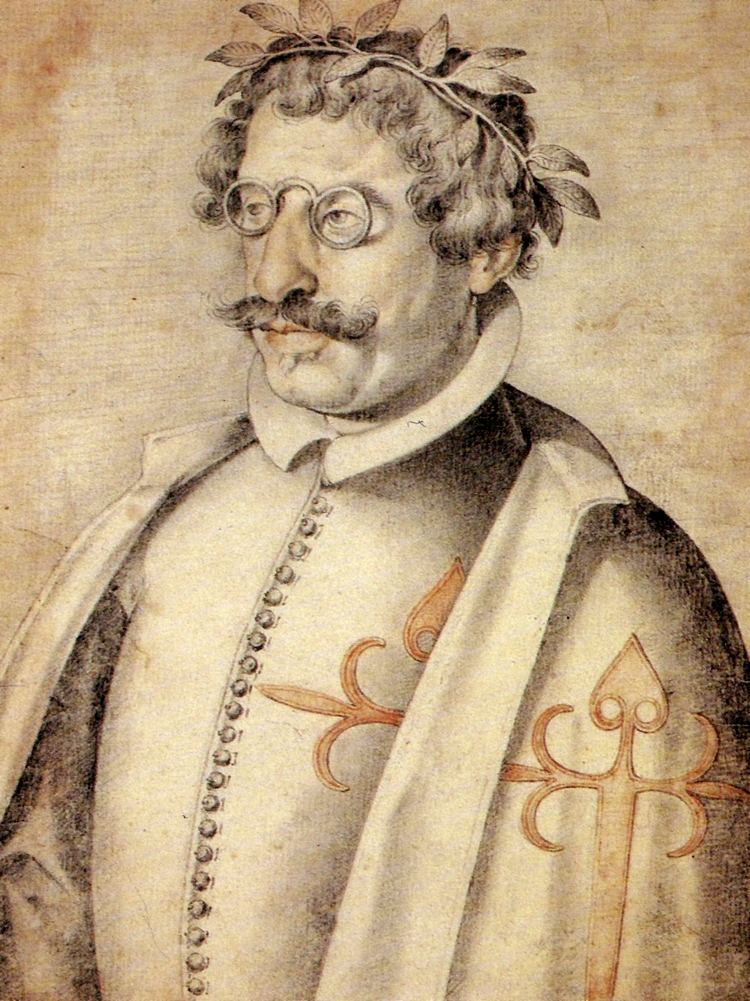
Biography
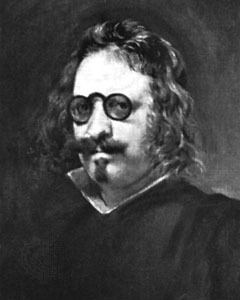
Quevedo was born in Madrid into a family of hidalgos from the village of Vejorís, located in the northern mountainous region of Cantabria. His family was descended from the Castilian nobility.

Quevedo's father, Francisco Gómez de Quevedo, was secretary to Maria of Spain, daughter of emperor Charles V and wife of Maximilian II, Holy Roman Emperor, and his mother, Madrid-born María de Santibáñez, was lady-in-waiting to the queen. Quevedo matured surrounded by dignitaries and nobility at the royal court. Intellectually gifted, Quevedo was physically handicapped with a club foot, and myopia. Since he always wore pince-nez, his name in the plural, quevedos, came to mean "pince-nez" in the Spanish language.
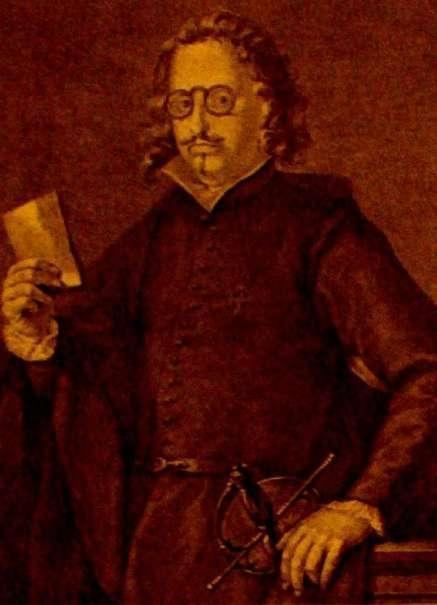
Orphaned by the age of six, he was able to attend the Imperial School run by the Jesuits in Madrid. He then attended university at Alcalá de Henares from 1596 to 1600. By his own account, he made independent studies in philosophy, classical languages, Arabic, Hebrew, French and Italian.
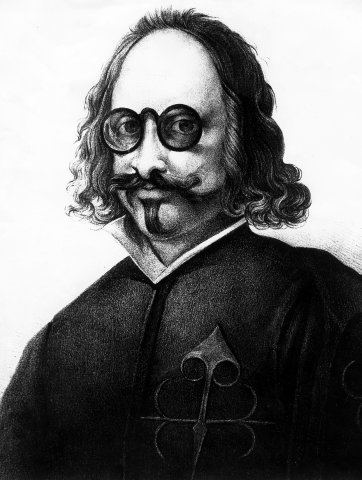
In 1601, Quevedo, as a member of the Court, moved to Valladolid, where the Court had been transferred by the King's minister, the Duke of Lerma. There he studied theology, a subject that would become a lifelong interest, and on which in later life he would compose the treatise Providencia de Dios (God's Providence), against atheism.
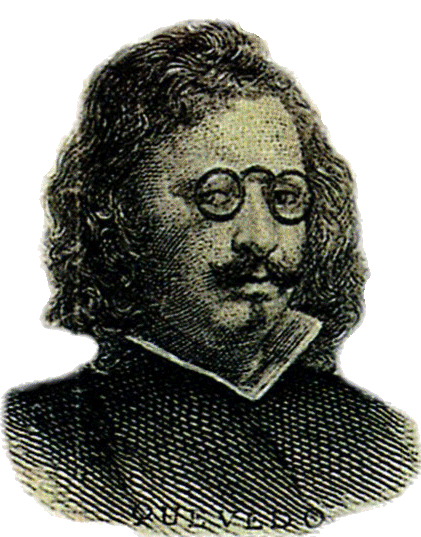
By this time, he was becoming noted as both a poet and a prose writer. Some of his poetry was collected in a 1605 generational anthology by Pedro Espinosa entitled Flores de Poetas Ilustres (Flowers by Illustrious Poets).
We can also date back to this time the first draft of his picaresque novel Vida del Buscón -apparently written as an exercise in courtly wit- and a few satirical pamphlets that made him famous among his fellow students and which he would later disown as juvenile pranks.
Around this time, he began a very erudite exchange of letters with the humanist Justus Lipsius, in which Quevedo deplored the wars that were ravaging Europe. The Court returned to Madrid in 1606, and Quevedo followed, remaining till 1611. By then, he was a well-known and accomplished man-of-letters. He befriended and was praised by Miguel de Cervantes and Lope de Vega, the premier playwright of the age.
Enemies
Quevedo's enemies included, among others, the dramatist Juan Ruiz de Alarcón for, despite his own physical handicaps, Quevedo found Alarcón's redheaded and hunchbacked physique a source of amusement. Quevedo also attacked Juan Pérez de Montalbán, the son of a bookseller with whom he had quarrelled, satirizing him in "La Perinola" ("The Whirligig"), a cruel piece that he included in his book Para Todos (To Everyone). In 1608, Quevedo dueled with the author and fencing master Luis Pacheco de Narváez as a result of Quevedo criticizing one of Pacheco's works. Quevedo took off Pacheco's hat in the first encounter. They remained enemies all their lives. In Quevedo's Buscón, this duel was parodied with a fencer relying on mathematical calculations having to run away from a duel with an experienced soldier.
Quevedo could be impulsive. He was present at the church of San Martín in Madrid when a woman praying there was slapped on the cheek by another man who had rushed up to her. Quevedo seized the man, dragging him outside the church. The two men drew swords, and Quevedo ran his opponent through. The man, who died of his wounds some time later, was someone of importance. Quevedo thus retired temporarily to the palace of his friend and patron, Pedro Téllez-Girón, 3rd Duke of Osuna.
The preferred object of his fury and ridicule, however, was the poet Góngora, whom, in a series of scathing satires, he accused of being an unworthy priest, a homosexual, a gambler, and a writer of indecent verse who used a purposefully obscure language. Quevedo lampooned his rival by writing a sonnet, "Aguja de navegar cultos," which listed words from Góngora's lexicon: "He would like to be a culto poet in just one day, / must the following jargon learn: / Fulgores, arrogar, joven, presiente / candor, construye, métrica, armonía..."
With the bluntness of his age, Quevedo mercilessly satirized even Góngora's physique, particularly his prominent nose (most famously in the sonnet "A una nariz", ["To a Nose"]), which in his day was thought to imply a Jewish heritage, with all the shame, possible censorship, and persecution that such a connection implied in the Spain of the time. Quevedo's "A una nariz" begins with the lines: Érase un hombre a una nariz pegado, / érase una nariz superlativa, / érase una nariz sayón y escriba, / érase un peje espada muy barbado.
Góngora reciprocated with almost equal virulence.
Relationships with the Duke of Osuna
About that time, Quevedo grew very close to Pedro Téllez-Girón, 3rd Duke of Osuna, one of the great statesmen and generals of the age, whom he accompanied as secretary to Italy in 1613, carrying out a number of missions for him which took him to Nice, Venice and finally back to Madrid. There he engaged in all manner of courtly intrigue to get the viceroyalty of Naples for Osuna, an effort that finally bore fruit in 1616. He then returned to Italy in the Duke's entourage, where he was entrusted with putting in order the Viceroyalty's finances, and sent on several espionage-related missions to the rival Republic of Venice, although it is now believed these did not involve him personally. He was rewarded for his efforts with a knighthood in the order of Santiago in 1618.
Temporary exile and retirement
With the fall from favor of Osuna in 1620, Quevedo lost his patron and protector and was exiled to Torre de Juan Abad (Ciudad Real), whose fiefdom his mother had purchased for him. His supposed vassals, however, refused to acknowledge him, forcing Quevedo into an interminable legal battle with the town's council that would not be won until after his death.
Quevedo would write some of his better poetry in this retirement, such as the sonnet "Retirado a la paz de estos desiertos..." or "Son las torres de Joray...". He found consolation to his failed ambitions as a courtier in the Stoicism of Seneca, his study and commentary turning him into one of the main exponents of Spanish Neostoicism.
The elevation of Philip IV to the throne in 1621 meant the end of Quevedo's exile, and his return to Court and politics, now under the influence of the new minister, the Count-Duke of Olivares. Quevedo accompanied the young king in trips to Andalusia and Aragon, recounting some of its various incidents in interesting letters.
At this time he decided to denounce to the Spanish Inquisition his own works, published without his consent by profiteering booksellers. It was a move to frighten off the booksellers and regain control over his writings, with a view to a definitive edition of his work that was not to come in his lifetime.
He became known for a disorderly lifestyle: he was a heavy smoker, a frequent visitor to brothels and taverns, and cohabited with a woman only known as "Ledesma." Góngora derided him as a drunkard in a satirical poem as Don Francisco de Quebebo (a play on his name that can be roughly translated as "Don Francisco of What-I-drink.")
None of this put a stop to his career at court, perhaps because the king had an equally rowdy reputation. In fact, in 1632 he would become secretary to the king, thus reaching the apex of his political career.
His friend Antonio Juan de la Cerda, the Duke de Medinaceli, forced Quevedo to marry against his will with Doña Esperanza de Aragón, a widow with children. The marriage, made in 1634, barely lasted three months. Quevedo filled these years with febrile creative activity.
In 1634 he published La cuna y la sepultura ("The cradle and the sepulchre") and the translation of La introducción a la vida devota ("The introduction to a life of devotion") of Francis of Sales; between 1633-1635 he completed works like De los remedios de cualquier fortuna ("Of the remedies of any fortune"), the Epicteto, Virtud Militante, Los cuatro fantasmas ("The four ghosts"), the second part of Política de Dios ("Politics of God"), Visita y anatomía de la cabeza del cardenal Richelieu ("Visit and anatomy of the head of the Cardinal Richelieu") or Carta a Luis XIII ("Letter to Louis XIII").
In 1635 there appeared in Valencia the most important of the numerous libels destined to defame him, El tribunal de la justa venganza, erigido contra los escritos de Francisco de Quevedo, maestro de errores, doctor en desvergüenzas, licenciado en bufonerías, bachiller en suciedades, catedrático de vicios y protodiablo entre los hombres. ("The Court of the rightful revenge, erected against the writings of Francisco de Quevedo, teacher of errors, doctor in shamelessness, licensed in buffonery, bachelor in dirt, university professor of vices and proto-devil among men").
Arrest and exile
In 1639, he was arrested. His books were confiscated. The authorities, hardly giving Quevedo time to get dressed, took the poet to the convent of San Marcos in León. In the monastery Quevedo dedicated himself to reading, as recounted in his Carta moral e instructiva (Moral and instructive letter), written to his friend, Adán de la Parra, depicting hour by hour his prison life ("From ten to eleven, I spend my time in prayer and devotions, and from eleven to noon I read good and bad authors; because there is no book, despicable as it can be, that does not contain something good...").
Quevedo, who was frail and very ill when he left from his confinement in 1643, resigned from royal court definitively to retire at Torre de Juan Abad. He died in the Dominican convent of Villanueva de los Infantes, on 8 September 1645. One tale tells that his tomb was pillaged days later by a gentleman who wished to have the gold spurs with which Quevedo had been buried.
Style
Quevedo was an adherent of the style known as conceptismo, a name derived from concepto, which has been defined as "a brilliant flash of wit expressed in pithy or epigrammatic style." Conceptismo is characterized by a rapid rhythm, directness, simple vocabulary, witty metaphors, and wordplay. In this style, multiple meanings are conveyed in a very concise manner, and conceptual intricacies are emphasised over elaborate vocabulary. Conceptismo can effect elegant philosophical depth, as well as biting satire and humor, such as in the case of the works of Quevedo and Baltasar Gracián.
The first tercet from Quevedo's sonnet "¡Ah de la vida!" is considered to exemplify conceptismo in poetry at its peak:
Ayer se fue, mañana no ha llegado,Hoy se está yendo sin parar un punto;Soy un fue, y un será y un es cansado.Poetry
Quevedo produced a vast quantity of poetry. His poetry, which was not published in book form during his lifetime, "shows the caricature-like vision its author had of men, a vision sometimes deformed by a sharp, cruel, violently critical nature." This attitude is of a piece with the "black seventeenth century" he lived in. Despite his satirical work, however, Quevedo was primarily a serious poet who valued love poems.
His poetry gives evidence not only of his literary gifts but also of his erudition (Quevedo had studied Greek, Latin, Hebrew, Arabic, French and Italian). His poetic works range from satirical and mythological subjects to love poetry and philosophical pieces.
Quevedo constantly attacked avarice and avaricious people. His "Cartas del Caballero de la Tenaza" attack a notorious tightwad. He also attacked apothecaries, who had a reputation for adulterating and badly preparing medications.
His love poetry includes such works as "Afectos varios de su corazón, fluctuando en las ondas de los cabellos de Lisi" ("Several reactions of his heart, bobbing on the waves of Lisi's hair"). As one scholar has written, "Even though women were never very much appreciated by Quevedo, who is labeled as a misogynist, it is impossible to imagine that there was anyone else who could adore them more." The first four lines run as follows:
Within a curly storm of wavy goldmust swim great gulfs of pure and blazing lightmy heart, for beauty eagerly athirst,when your abundant tresses you unbind.His work also employed mythological themes, typical of the age, though it also employs satirical elements, for example in his "To Apollo chasing Daphne":
Ruddy silversmith from up on high,in whose bright beams the rabble pick their fleas:Daphne, that nymph, who takes off and won't speak,if you'd possess her, pay, and douse your light.Quevedo's poetry also includes pieces such as an imagined dedication to Columbus by a piece of the ship in which the navigator had discovered the New World:
Once I had an empire, wanderer,upon the billows of the salty sea;I was moved by the wind and well-respected,to southern lands I forged an opening.Novels
The only novel written by Quevedo is the picaresque Vida del Buscón or El Buscón (Full title: Historia de la vida del Buscón, llamado Don Pablos, ejemplo de vagamundos y espejo de tacaños (1626; "Paul the Sharper or The Scavenger; The Swindler"). It is a work divided into three books.
Theological works
Quevedo produced about 15 books on theological and ascetic subjects. These include La cuna y la sepultura (1612; "The Cradle and the Grave") and La providencia de Dios (1641; "The Providence of God").
Literary criticism
His works on literary criticism include La culta latiniparla ("The Craze for Speaking Latin") and Aguja de navegar cultos (Compass for Navigating among Euphuistic Reefs). Both works were written with the purpose of attacking culteranismo.
Satire
Quevedo's satire includes Sueños y discursos, also known as Los Sueños (1627; "Dreams and Discourses"). Quevedo employed lots of word-play in this work, which consists of five "dream-visions." The first is "The Dream of the Last Judgment", in which Quevedo finds himself witnessing the Day of Judgment, and closes with a glimpse of Hell itself. The second dream is "The Bedeviled Constable" in which constable is possessed by an evil spirit, which results in the evil spirit begging to be exorcised, since the constable is more evil of the two. The third dream is the long "The Vision of Hell". The fourth dream-vision is called "The World from the Inside". The last dream is "The Dream of Death", in which Quevedo offers examples of man's dishonest ways.
In the Dreams, the somewhat misanthropic Quevedo showcased his antipathy for numerous groups, including but not limited to tailors, innkeepers, alchemists, astrologers, women, the Genovese, Protestants, constables, accountants, Jews, doctors, dentists, apothecaries, and hypocrites of all kinds.
He wrote too, in a satirical tone, La hora de todos y la Fortuna con seso (1699), with many political, social and religious allusions. He shows his ability in the use of language, with word-play and fantastic and real characters.
Political works
His political works include La política de Dios, y gobierno de Cristo (1617–1626; "The Politics of the Lord") and La vida de Marco Bruto (1632–1644; "The Life of Marcus Brutus"). According to writers Javier Martínez-Pinna and Diego Peña In his writings he always manifested an obsession for the defense of the country, being convinced of the necessity and inevitability of the hegemony of Spain in the world, something that in the full Spanish decline had to do him much harm. It was also integrated in the tradition of laus Hispaniae, established by San Isidoro and used by Quevedo himself to try to recover the values that he thought, made the nation powerful. In a series of works like his defended Spain, he praised the greatness of his most prestigious compatriots, highlighting the Spanish superiority in the field of letters, visible in authors such as Fray Luis de León, Jorge Manrique or Garcilaso de la Vega, but also in The art of war, making possible the victory of Castilian weapons in their confrontations against Arabs and other European powers during the sixteenth century
